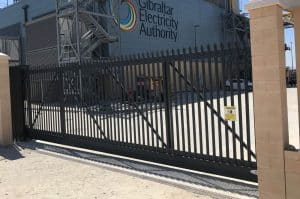High-security Gates and How to Specify Them
22nd December 2014

Procter Contracts design, manufacture and installs sliding gates for all types of premises where high-security perimeter protection is required
Jeremy Procter, the Managing Director of Procter Automatic Gates, explains why powered sliding gates can be particularly beneficial for premises requiring high-security perimeter protection, and what to consider when specifying high-security gates.
Perimeter security is the first line of defence for premises, whatever the threat, so a combination of fencing, gates and associated security measures will provide both protection and a deterrent.
Perimeter security is only as good as the ‘weakest link’ and care must be taken to ensure that access points are no less secure than the fencing. As a general rule, the number of access points should be kept to a minimum, though for reason of health and safety it is good practice to have separate access points for vehicles and pedestrians.
Pedestrian gates will normally be of the swing type unless turnstiles are deemed to be more appropriate as part of an access control system. For vehicular access, however, there is a choice between swing gates and sliding gates, with bi-folding gates and telescopic gates being additional alternatives where space constraints are particularly severed. Swing and sliding types both offer similar protection from cutting and climbing, but high-security sliding gates offer significantly better resistance to force. The main reason for this is that part of the gate leaf is retained within a rigid structure. When closed, single-leaf gates are retained at both ends, and double-leaf gates are retained end – which is still an inherently stronger arrangement than swing gates mounted on hinges. Because of the way the gate leaves are retained, they are much more difficult to force open, either by tampering with the fixings and locking mechanisms or by ramming. In addition, the more vulnerable points of a sliding gate are less accessible than those of swing gates.
Another feature of sliding gates is that they are highly suitable for mechanisation using a robust, long-lasting operating mechanism that is protected from the elements and from attack. Furthermore, a multitude of different access control system can be employed, ranging from keypads and intercoms (wireless, if necessary), to in-vehicle radio control, automatic number plate recognition (ANPR) and induction loops. The choice of access control will depend on factors such as the number of vehicles requiring access, the level of security required, and whether there is an existing site-wide security system within which the gate controls must be integrated.
Procter Automatic Gates manufactures the Pro-glide comprehensive range of high-quality yet competitively-priced sliding gates – which includes high-security gates. To complement the gates, the company can also supply and install access control, and a sister division of the same company, Procter Fencing Systems, supplies and installs high-security perimeter fencing and associated security measures. The Series 10, Series 20 and Series 30 Pro-glide cantilevered can tracked sliding gates give specifiers an exceptionally broad choice of options to suit an almost unlimited variety of commercial, industrial and public sector applications. Moreover, custom-made gates are available within the same timescale and cost structure.
Procter Automatic Gates can help architects and specifiers specify high-security gates that will meet al security, performance and safety requirements. If a gate specification has already been prepared, the company offers a free Automatic Gate Specification Checking Service to help ensure the gates meet all current safety standards and guidance from the HSE (Health and Safety Executive) and the Powered Gates Group of the DHF (Door and Hardware Federation). In addition, Procter Automatic Gates has prepared a number of free Guides, Calculators and White Paper to support architects and specifiers. These are available from the Downloads section of the website. Alternatively, email [email protected] to discuss any aspects of high-security gates or particular projects.
